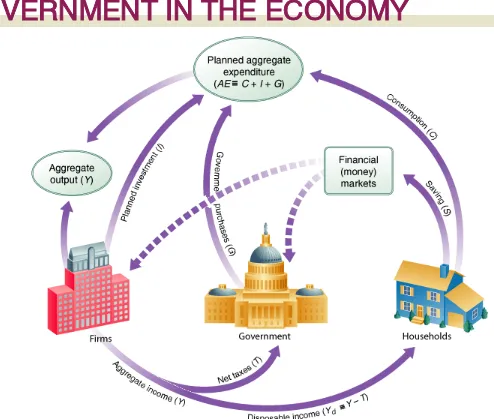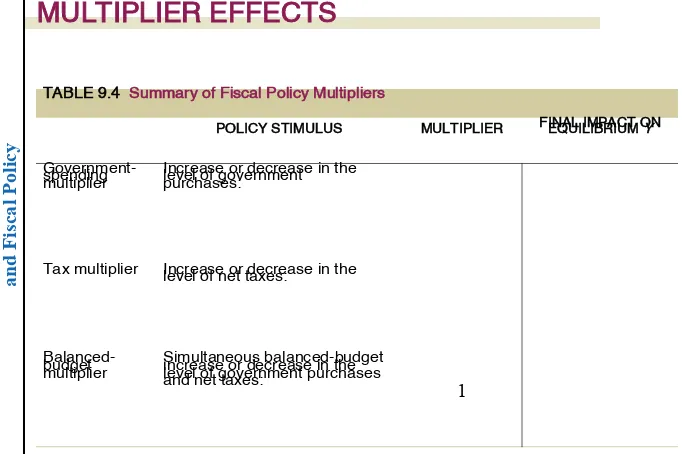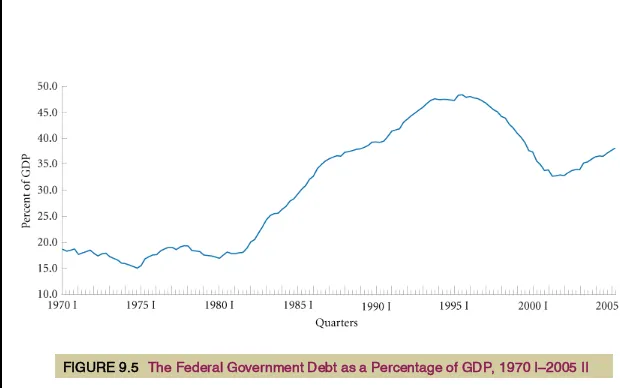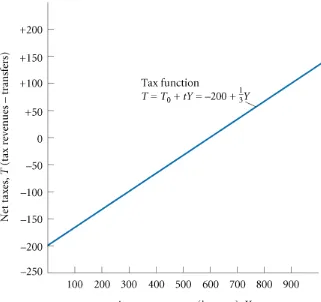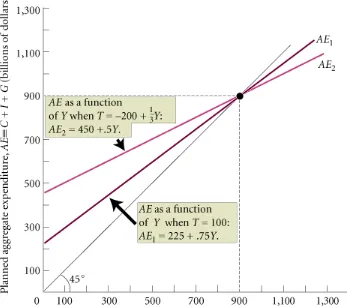Prepared by:
Fernando & Yvonn
Quijano
22
Chapter
The Government
C
and Fiscal Policy
Government in the Economy
Government Purchases (G), Net Ta xes (T), and Disposable income (Y
d)
Equilibrium Output: Y = C + I + G
Fiscal Policy at Work: Multiplier Effects
The Government Spending Multiplier The Ta x Multiplier
The Balanced-Budget Multiplier
The Federal Budget
The Budget
The Surplus or Deficit The Debt
The Economy’s Influence on the Government Budget
C
THE GOVERNMENT AND FISCAL POLICY
fiscal policy
The government’s spending
and taxing policies.
monetary policy
The behavior of the
Federal Reserve concerning the nation’s
C
discretionary fiscal policy
Changes in
taxes or spending that are the result of
deliberate changes in government
C
GOVERNMENT IN THE ECONOMY
GOVERNMENT PURCHASES (
G
), NET TAXES (
T
),
AND DISPOSABLE INCOME (
Y
D
)
net taxes (
T
)
Ta xes paid by firms and
households to the government minus
transfer payments made to households
C
GOVERNMENT IN THE ECONOMY
disposable, or after-tax, income (
Y
d
)
To tal income minus net taxes:
Y
−
T
.
disposable income
≡
total income
−
net taxes
C
When government enters the picture, the aggregate
income identity gets cut into three pieces:
C
GOVERNMENT IN THE ECONOMY
budget deficit
The difference between
what a government spends and what it
collects in taxes in a given period:
G
−
T
.
C
Adding Ta xes to the Consumption Function
To modify our aggregate consumption function to
incorporate disposable income instead of
before-tax income, instead of
C
=
a
+
bY
, we write
C
=
a
+
bY
dor
C
=
a
+
b
(
Y
−
T
)
Our consumption function now has consumption
depending on disposable income instead of
C
GOVERNMENT IN THE ECONOMY
Investment
C
(All Figures in Billions of Dollars)
(1) (2) (3) (4) (5) (6) (7) (8) (9) (10)
300 100 200 250
50 100 100 450 150 Output
500 100 400 400 0 100 100 600 100 Output
700 100 600 550 50 100 100 750 50 Output
900 100 800 700 100 100 100 900 0 Equilibrium 1,100 100 1,000 850 150 100 100 1,050 + 50Output
1,300 100 1,200 1,000 200 100 100 1,200 + 100Output
1,500 100 1,400 1,150 250 100 100 1,350 + 150C
GOVERNMENT IN THE ECONOMY
C
The Leakages/Injections Approach to Equilibrium
leakages/injections approach to equilibrium:
S
+
T
=
I
+
G
Ta xes (
T
) are a leakage from the flow of income. Saving
(
S
) is also a leakage.
In equilibrium, aggregate output (income) (
Y
) equals
C
FISCAL POLICY AT WORK:
MULTIPLIER EFFECTS
THE GOVERNMENT SPENDING MULTIPLIER
TABLE 9.2
Finding Equilibrium After a $50 Billion Government Spending Increase (All
Figures in Billions of Dollars; G Has Increased from 100 in Ta ble 9.1 to
150 Here)
300 100 200 250
50 100 150 500 200 Output
500 100 400 400 0 100 150 650 150 Output
700 100 600 550 50 100 150 800 100 Output
900 100 800 700 100 100 150 950 50 Output
1,100 100 1,000 850 150 100 150 1,100 0 Equilibrium 1,300 100 1,200 1,000 200 100 150 1,250 + 50C
government spending multiplier
The
ratio of the change in the equilibrium
level of output to a change in
C
FISCAL POLICY AT WORK:
MULTIPLIER EFFECTS
C
THE TAX MULTIPLIER
tax multiplier
The ratio of change in
the equilibrium level of output to a
change in taxes.
C
FISCAL POLICY AT WORK:
C
THE BALANCED-BUDGET MULTIPLIER
balanced-budget multiplier
The ratio of
change in the equilibrium level of
output to a change in government
spending where the change in
government spending is balanced by a
change in taxes so as not to create any
deficit. The balanced-budget multiplier
is equal to 1: The change in
Y
resulting from the change in
G
and the
equal change in
T
is exactly the same
size as the initial change in
G
or
T
C
FISCAL POLICY AT WORK:
MULTIPLIER EFFECTS
C
TABLE 9.3
Finding Equilibrium After a $200-Billion Balanced-Budget Increase in G
and T (All Figures in Billions of Dollars; Both G and T Have Increased
from 100 in Ta ble 9.1 to 300 Here)
500 300 200 250 100 300 650
150 Output
700 300 400 400 100 300 800 100 Output
900 300 600 550 100 300 950 50 Output
1,100 300 800 700 100 300 1,100 0 Equilibrium 1,300 300 1,000 850 100 300 1,250 + 50Output
1,500 300 1,200 1,000 100 300 1,400 + 100C
FISCAL POLICY AT WORK:
MULTIPLIER EFFECTS
TABLE 9.4
Summary of Fiscal Policy Multipliers
POLICY STIMULUS
MULTIPLIER
FINAL IMPACT ON
EQUILIBRIUM Y
Government-spending
multiplier
Increase or decrease in the
level of government
purchases:
Ta x multiplier
Increase or decrease in the
level of net taxes:
Balanced-budget
multiplier
Simultaneous balanced-budget
increase or decrease in the
level of government purchases
and net taxes:
C
C
THE FEDERAL BUDGET
THE BUDGET
TABLE 9.5
Federal Government Receipts and Expenditures, 2004 (Billions of Dollars)
AMOUNT
PERCENTAGE
OF TOTAL
Receipts
Personal income taxes 801.8 40.6
Excise taxes and custom duties 94.0 4.8
Corporate income taxes 217.4 11.0
Ta xes from the rest of the world 9.2 0.5
Contributions for social insurance 802.5 40.6
Interest receipts and rents and royalties 21.9 1.1
Current transfer receipts from business and persons 28.6 1.4
Current surplus of government enterprises − 0.5 0.0
To tal 1,974.8 100.0
Current Expenditures
Consumption expenditures 725.7 30.5
Transfer payments to persons 1,014.0 42.6
Transfer payments to the rest of the world 28.9 1.2
Grants-in-aid to state and local governments 348.3 14.6
Interest payments 221.5 9.3
Subsidies 43.0 1.8
To tal 2,381.3 100.0
